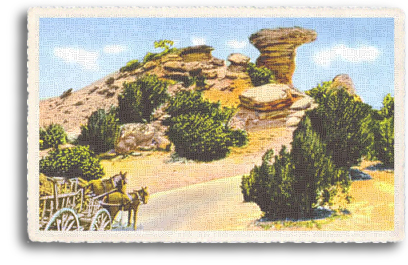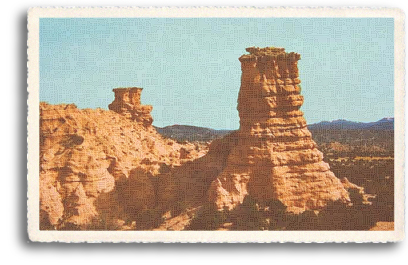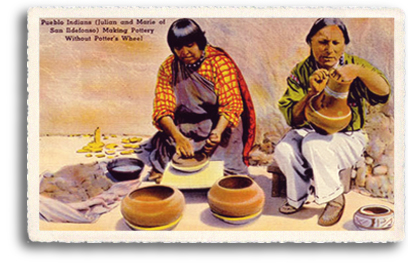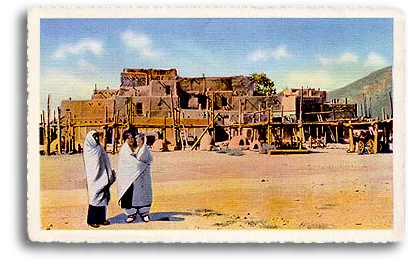 |
||
The Eight Northern New Mexico Indian Pueblos  Tesuque Pueblo Located just nine miles north of Santa Fe, Tesuque Pueblo has the most intimate relationship to the state capital, and is therefore probably the most recognizable of the Eight Northern Indian Pueblos. Seventeen thousand acres of piñon-covered hills and extraordinary red-rock formations (including the famous “Camel Rock”) is home to 450 Tewa people. One of the most traditional of all New Mexican pueblos, its feast days and annual dances are open to the public, but photography is strictly prohibited. The Pueblo owns and operates the Camel Rock Casino and Hotel, and the highly popular Tesuque Pueblo Flea Market. The nearby picturesque wooded village of Tesuque is home to people from all walks of life. To learn more about the art and history of Tesuque Pueblo, click here. Pojoaque Pueblo Located fifteen miles north of Santa Fe on US 84/285, the Pojoaque Pueblo is probably the most visibly developed Pueblo in the Northern New Mexico area. Its shopping center, bank, tribal buildings, Cities of Gold Casino and Hotel, and the Towa Golf Course run right along the highway. After being decimated by smallpox 100 years ago, the Pueblo was abandoned and not inhabited again until 1915. The piñon-covered foothills of the Sangre de Christo Mountains offer a still-tranquil setting for this upwardly-mobile 21st-century Pueblo, which is careful to maintain a balance between the ancient past and the far-reaching future. Many Hispanics and Anglos live in the neighboring areas and are warmly welcomed to shop and do business on the Pueblo. To learn more about the art and history of Pojoaque Pueblo, click here.  Nambe Pueblo Nambe PuebloLocated 18 miles north of Santa Fe off US 84/285 and NM 503, Nambe Pueblo is set in the panoramic foothills of the Sangre de Christo Mountains. A drive through this area offers some of the most uniquely breathtaking scenery in the New Mexico high desert. Established in the 1300s, Nambe Pueblo was originally a primary cultural and religious center. Sadly, upon their arrival, the Spanish conquerors brought the area to nearly complete destruction. Today, approximately 600 tribal members live on the 19,000-acre reservation. An important part of the Pueblo is the beautiful Nambe Falls Recreation Area. This is a wonderful place to kick back and enjoy nature. Aside from the hike up the mountain to view the falls, Nambe Falls offers swimming, boating, lake fishing and seasonal camping. To learn more about the art and history of Nambe Pueblo, click here.  San Ildefonso Pueblo San Ildefonso PuebloLocated 22 miles north of Santa Fe off NM 502, the San Ildefonso Pueblo lies in a lovely country-like area between Nambe and Los Alamos. The ancestors of these people originally lived at Bandelier and Mesa Verde, Colorado, but due to a long-lasting drought, those earlier sites were abandoned. The identifying landmark of the area is the extraordinary Black Mesa, which can be seen for miles around. It was from the top of Black Mesa that the San Ildefonso people fought off Spanish soldiers in 1694. Today, San Ildefonso has preserved its cultural identity and still observes ancient traditions. The central plaza looks much the same as it has for several hundreds of years, with adobe homes surrounding it, though it now backs up to the non-pueblo, modern-day residential area of El Rancho. To learn more about the art and history of San Ildefonso Pueblo, click here. Santa Clara Pueblo Located off State Road 30, twenty-six miles north of Santa Fe, the Santa Clara Pueblo is in close proximity to the town of Española. Their ancestors originally lived in carved cave dwellings in the Puye Cliffs, but a period of drought forced their relocation to the fertile Española Valley, known as the primary farming area of Northern New Mexico. Today, a drive through the Santa Clara Pueblo clearly illustrates the adaptation of the New Mexico native peoples to modern-day living. The Pueblo’s 50,000 acre reservation is one of the largest of the Eight Northern New Mexico Pueblos. They own and operate the Big Rock Casino and Bowling Alley in the heart of Española, and the newly developed Black Mesa Golf Course. To learn more about the art and history of Santa Clara Pueblo, click here. San Juan Pueblo Located just two miles north of the town of Española, the San Juan Pueblo is the largest of the Tewa pueblos. Central plazas are bordered by a Catholic church, kivas and a chapel. Today, many of the original 700 homes, dating back before the pilgrims arrival at Plymouth Rock, are still standing adjacent to the Rio Grande river in the fertile Española Valley. The Pueblo owns the Ohkay Casino and a successful RV park and campground, which are open to travelers year round. To learn more about the art and history of San Juan Pueblo, click here. Picuris Pueblo Located 15 miles from Embudo on State Road 73, Picuris Pueblo is the smallest and most remote of Northern New Mexico pueblos. Nestled in a wooded valley of the Sangre de Christo Mountains, the Pueblo is home to several hundred natives. A restored adobe church is the centerpiece of the Pueblo and the modern-day aspects of the Pueblo include Hotel Santa Fe, a restaurant, a museum, and a gift shop all open to visitors. To learn more about the art and history of Picuris Pueblo, click here.  Taos Pueblo Located just north of the town of Taos, the Taos Pueblo sits at the base of the Taos Mountains, surrounded by fertile pastures and farmlands. Home to the Red Willow People, Taos Pueblo has survived the invasion of the Spanish in the 1540s, the Pueblo Revolt of 1680, and the Taos Rebellion against the United States government in 1847. Today, as in the past, the Tewa people are skilled leatherworkers, producing moccasins, drums and leather clothing that are sold in local shops in Taos. They also own and operate the Taos Mountain Casino just south of the Pueblo. Probably the most-visited pueblo in New Mexico, a journey to this sacred ground offers the most authentic look at the lifestyle of the ancient pueblo peoples. Learn more about the art and history of Taos Pueblo |
||
Home | Food | Lodging | Merchants | Services | Real Estate | Art & Galleries | Entertainment | Recreation Ski Areas | Mind-Body-Spirit | Santa Fe Information | Local Color | Canyon Road | The Turquoise Trail | Santa Fe Plaza The Pueblos | Scenic Beauty | Day Trips | Chili | Special Events | Santa Fe History | Multicultures | Museums High Road to Taos | The Wild West | Churches | Plants & Wildlife | Santa Fe Railyard | Turquoise | Architecture Fiesta | Indian Market | Spanish Market | Zozobra | Features | About Us | Get Listed! | Santa Fe Unlimited Trading Post Photo of the Week | Link of the Month | Testimonials | Santa Fe Webcams | Santa Fe Weather Santa Fe A to Z | Movie Locations | Santa Fe Unlimited Guestbook | Sitemap | Contact Us | Taos Unlimited |
||